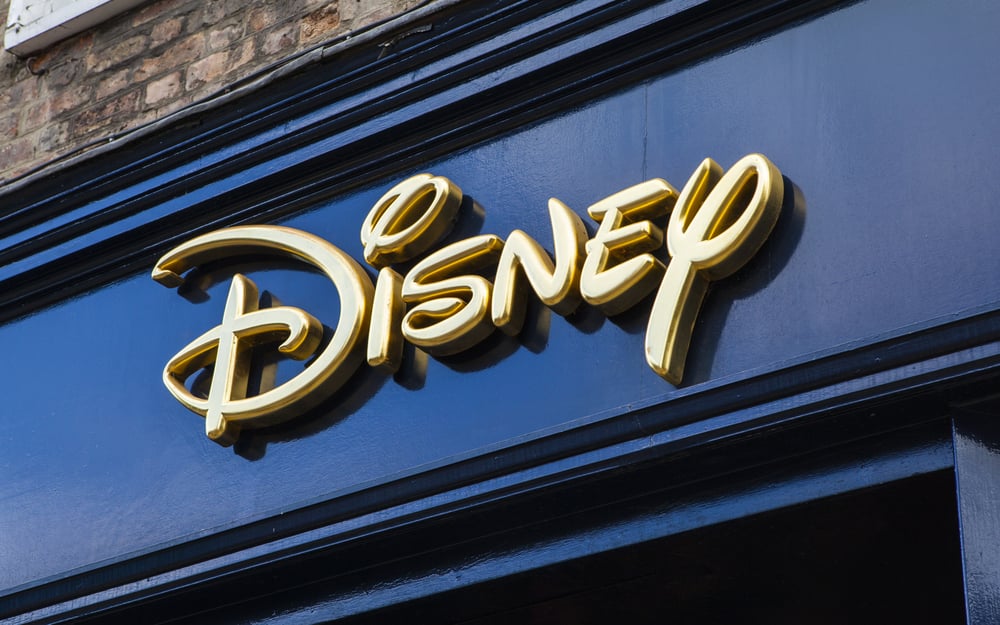Walt Disney Company Goes Big On Blockchain With Dragonchain

| Source: Shutterstock
The Walt Disney Company is #71 of the top 2000 companies in the world ranked by Forbes. It has an annual revenue in the tens of billions of dollars, assets near 100 billion dollars, and recently developed a keen interest in blockchain technology for use within its massive organization, which includes online retail, television endeavors, and, of course, their world-famous theme parks.
The most obvious benefit of a blockchain system is easier tracking of inventories, sales, shipments, and even people in the case of the parks, but Dragonchain innovates on existing blockchain implementations. According to their design document, they introduce something called “context-based verification.” Their blockchain will have various types of nodes, and a “level 5” of these nodes will interact with an existing public blockchain like Bitcoin, notably providing a “public checkpoint” or “proof of existence” for the blocks within the permissioned ledger.
The other levels of the Dragonchain should be noted for understanding. The first level is the business node, which will process transactions and be able to determine whether a transaction is approved or declined. Level two is an enterprise verification node, which can determine the validity of data submitted by level one nodes. The purpose of the level three nodes is to ensure requisite diversity of sources of information – it acts as a check against errant nodes which may be compromised, for one thing. Dragonchain also calls for a third-party verification/“independent witness” of data at its level 4 nodes, to whit:
Hosted by an external partner, a level 4 node would cryptographically sign any level 3 verification records that it receives. This function allows the Level 4 node to act as an independent witness to level 3 verifications.
After level 5, which was described earlier, a business may implement other forms of verification for its own purposes.

Another feature of the Dragonchain is that it will not have a singular currency at its heart in the way that Bitcoin does. Instead, they believe that if a base currency were to be required within an organization, then a separate node should manage it. For the purpose of the Dragonchain, though, a multitude of currencies should be considered. Quoting page 10 of the design document [PDF]:
[…] this architecture should not define a “base” currency, or one that the system itself runs upon. If such a use case arises (as indeed it is very likely to see value in the availability of a currency whereby nodes may pay each other for verifications), it is the philosophy of this architecture that a node should be configured to create and maintain that currency. This will allow a more flexible development of marketplaces than any attempt to define that early in the development of the platform.
 And most interesting about this is that the Dragonchain will apparently support multiple cryptocurrencies inside a private blockchain transaction, using their transaction class header field. At least at the outset, the network will use Bitcoin-based cryptographic addressing and cryptography. Part of the logic behind this is to make use of existing infrastructure, including Counterparty and hardware wallets for verification purposes within the organization.
And most interesting about this is that the Dragonchain will apparently support multiple cryptocurrencies inside a private blockchain transaction, using their transaction class header field. At least at the outset, the network will use Bitcoin-based cryptographic addressing and cryptography. Part of the logic behind this is to make use of existing infrastructure, including Counterparty and hardware wallets for verification purposes within the organization.
Blockchain of Blockchains
Different organizations will have different purposes for Dragonchain, but one thing that may make it very useful is its ability to act as a “blockchain of blockchains.” In this way, various third-party providers can bring to market solutions based on Dragonchain or to integrate competitively with existing Dragonchain implementations. Or, perhaps easier to imagine, third-party vendors can come up with interesting applications, such as methods of tracking inventory, event attendance, line congestion at theme park attractions, and more.
[…] each business concern will generally have its own node to do this work, each with its own blockchain. It is where these blockchains become combined that consensus is reached.
So it would seem that while Dragonchain will have immediate use within the company that commissioned and designed it, it will also, inevitably, open up new business opportunities for blockchain companies within Disney and other firms which integrate the system.
Dragonchain aims to have “simple architecture” and to be accessible to those who lack “Blockchain expertise.” While banks and other large financial institutions have been going on about the value of the blockchain and their perceived lack of necessity for Bitcoin, Dragonchain seems right at home with the idea of integrating various cryptocurrencies, and even with the idea of enterprises using a system such as Counterparty to instantiate their own tokens. This, to say the least, is refreshing from the perspective of a cryptocurrency enthusiast.
The code currently available in Dragonchain’s G6ithub repository is functional, well-documented, and includes the ability to transact on the Dragonchain, query the Dragonchain, and process the blockchain. A full Dragonchain implementation would require a clarity of purpose as well as the technical prowess to modify each level of node accordingly. Its largest requirements are Python and Postgres, both of which are cross-platform.
It would seem that the currently available setup is best suited to large-scale operations like Disney, but that a “lite” version could eventually come about as a result of the software being open source.
Images from Shutterstock and Dragonchain.